Pushing a shopping cart with two children, César Alegre emerges from the large, deteriorated house near Peru's presidential palace that is shared by 45 families to search for food. Sometimes he begs in markets. Sometimes he sells candies.
It is a task that was hard at the best of times, but with a month-long quarantine that has forced 32 million Peruvians to stay home and closed restaurants and food kitchens, it has become much harder.
"We eat once or twice a day,” said the 52-year-old, who says he has spent time in six different prisons for theft. Many among the 100 or so residents of the three-story house are ex-convicts who can't find work. The old building is opposite Lima's San Lazaro church, which was founded in 1650 as a hospital for refugees from a leprosy outbreak.
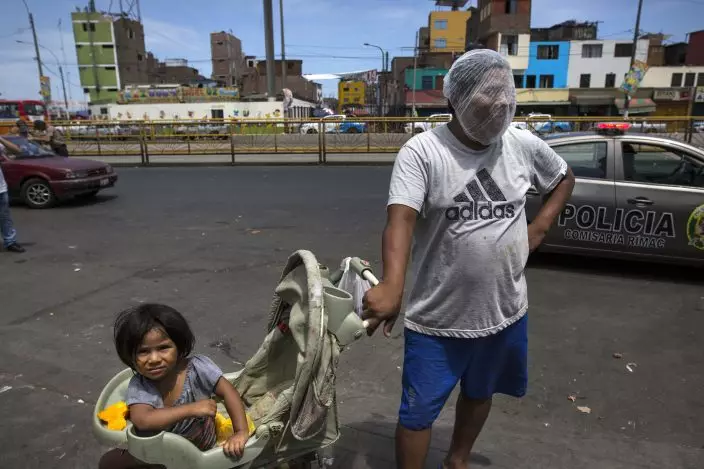
In this March 19, 2020 photo, Luis Mendoza jokingly dons a hair net over his face given to him by a group handing out protective gear outside a popular market where he has come to beg for food with his 2-year-old daughter Alejandra, in Lima, Peru. The global COVID-19 pandemic has spotlighted the wide gap between the rich and poor in Latin America and economists say a looming economic recession worse than any since World War II could push the continent's long-suffering poor into even more dire circumstances. (AP PhotoRodrigo Abd)
Alegre and his children, accompanied by a handful of neighbors, normally start out by walking about 2 miles (3 kilometers) to a market where they ask for food. The merchants give them potatoes, meat bones and overripe fruit that nobody wants to buy.
But these days the merchants are refusing to give them as much food, if any at all, because their sales have fallen amid the pandemic and strict measures that have kept people at home and shuttered the restaurants that would buy their goods.
“They’re vagrants,” said a meat vendor of the inhabitants of Alegre's building, which has earned the nickname “Luriganchito,” or “Little Lurigancho,” after Peru's most-populous prison, for the number or ex-convicts who reside there. The vendor said two weeks ago a young man from the building stole a bag of fish.
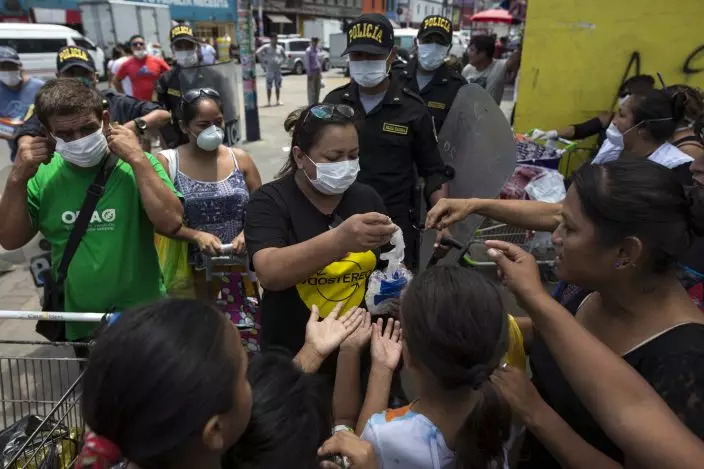
In this March 19, 2020 photo, Cesar Alegre, far left, and fellow residents who share a sprawling rundown house, receive free protective gear to help curb the spread of the new coronavirus, outside a popular food market in Lima, Peru. Alegre and his children, accompanied by a handful of residents, start out by walking about 2 miles (3 kilometers) to the market where merchants give them potatoes, meat bones and overripe fruit that nobody wants to buy. (AP PhotoRodrigo Abd)
Besides begging in markets, Alegre also sells candy on buses. Nowadays, passengers wear face masks and don't like strangers coming near them.
“The virus has highlighted the selfishness that man carries inside,” he said.
The pandemic has spotlighted the wide gap between rich and poor in Peru and elsewhere in Latin America, and economists say a looming recession worse than any since World War II could push the continent's long-suffering poor into even more dire circumstances.
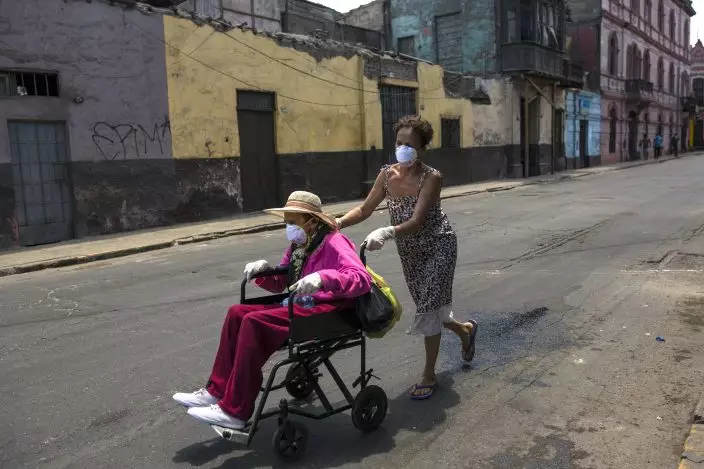
In this March 18, 2020 photo, Flor Vaso pushes her 84-year-old mother Carmen Reyes in a wheelchair to their home, in Lima, Peru. Vaso and her mother reside with 44 other families in a large, deteriorated house near the presidential palace that has earned it the nickname “Luriganchito,” or “Little Lurigancho,” after San Pedro de Lurigancho, the country’s most populous prison. (AP PhotoRodrigo Abd)
“The economic impact of what is happening is unprecedented,” said Peru's economy minister, María Alva.
For most people, the new coronavirus causes mild or moderate symptoms, such as fever and cough that clear up in two to three weeks. For some, especially older adults and people with existing health problems, it can cause more severe illness, including pneumonia and death.
As of Sunday night, Peru had 2,281 confirmed coronavirus cases, with 83 deaths, The government has steadily tightened bans and lock-downs to slow the spread of the virus. This past week it ordered that only men can leave the house on Mondays, Wednesdays and Fridays, while only women can go out on Tuesdays, Thursdays and Saturdays. The trips can only be to the market, pharmacy or bank.

In this March 23, 2020 photo, pedestrians walk past the yellow deteriorating house nicknamed “Luriganchito” after the country’s most populous prison, in Lima, Peru, located a few blocks from the presidential palace. The building is a relic from the area's historic era. But inside its now-cracked walls is a warren of narrow, dark passageways that smell of damp clothing and marijuana. (AP PhotoRodrigo Abd)
To try to address the humanitarian disaster, Peru has begun distributing about $400 million to feed 12 million poor people for one month.
But the money doesn't seem to be reaching most of the families in Alegre's sprawling shared house. The building in Lima's Rimac district is a relic from the area's historic era and still has balconies from its better days. But inside its now-cracked walls is a warren of narrow, dark passageways that smell of damp clothing and marijuana. Children run through them barefoot as cockroaches scatter to avoid being crushed.
Its residents have stories of hard luck and tough living.
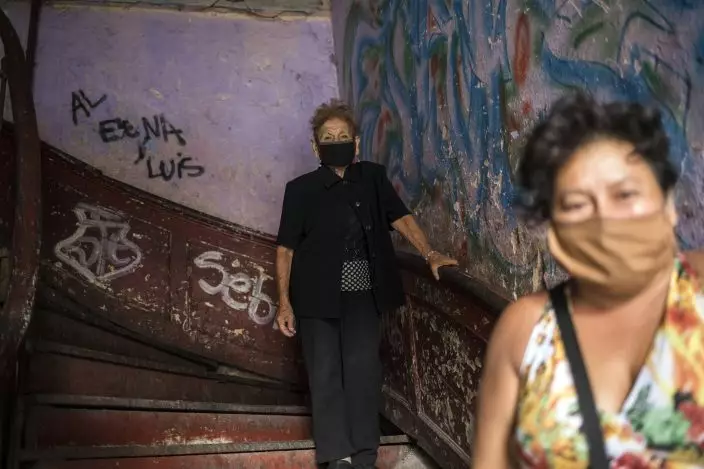
In this March 29, 2020 photo, 72-year-old Maria Isabel Aguinaga, wearing a protective face mask, descends the stairs of her crumbling residential building nicknamed “Luriganchito” after the country’s most populous prison, in Lima, Peru. To try to address the coming humanitarian disaster, Peru has begun distributing about $400 million to feed 12 million poor people for one month. But the money doesn't seem to be reaching most of the families in the sprawling shared house. (AP PhotoRodrigo Abd)
Santos Escobar, a 68-year-old former mug seller, ended up living in “Luriganchito” after his house burned down twice. In the first fire, two of his six daughters died. In the second, both his legs were burned.
Nélida Rojas, 59, had a stroke two years ago that partially paralyzed her. She now uses crutches and begs for alms.
Nilú Asca is a 24-year-old single mother with two daughters. The youngest is 2 and has some type of hip dislocation or problem that forces her to wear a plaster cast.
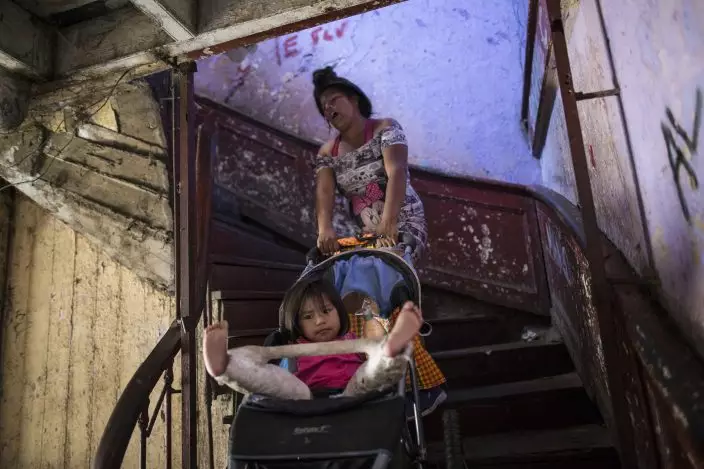
In this March 18, 2020 photo, Nilu Asca, a 24-year-old single mother, struggles to pull a stroller holding her 2-year-old daughter Darleth up a flight of stairs, inside a building nicknamed “Luriganchito” after the country’s most populous prison, in Lima, Peru. Darleth has been diagnosed with hip dysplasia and must wear a spica cast. She and her mother are one of 44 families who reside in one of the small rooms of the deteriorating building, just a few blocks from the presidential palace. (AP PhotoRodrigo Abd)
Eating with his children in their small room, Alegre watches the news on an old television set. He believes what is preventing looting is the deployment of 140,000 uniformed officers to guard food markets and banks.
But his long-term outlook is not optimistic.
“There are a lot of desperate people. They could rise up if they don't get help,” said Alegre.
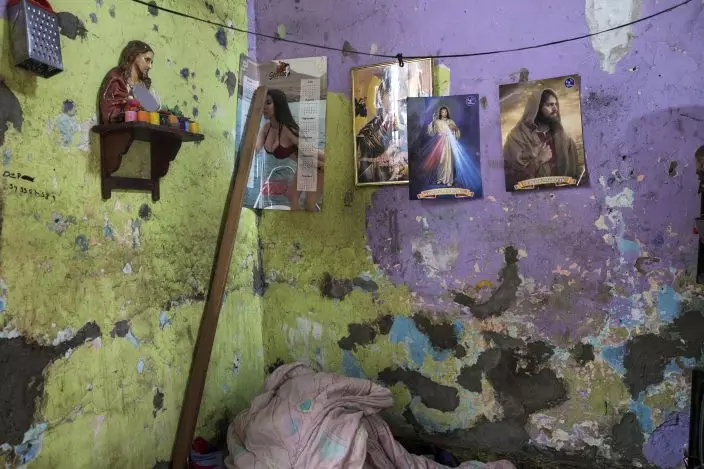
This March 26, 2020 photo shows the paint peeling on the cracked walls of Santos Escobar’s small room and his few belongings in a crumbling building nicknamed “Luriganchito” after the country’s most populous prison, where its residents have stories of hard luck and tough living, in Lima, Peru. Escobar, a 68-year-old former mug seller, ended up living in the shared house after his home burned down twice. In the first fire, two of his six daughters died; in the second, both his legs were burned. (AP PhotoRodrigo Abd)
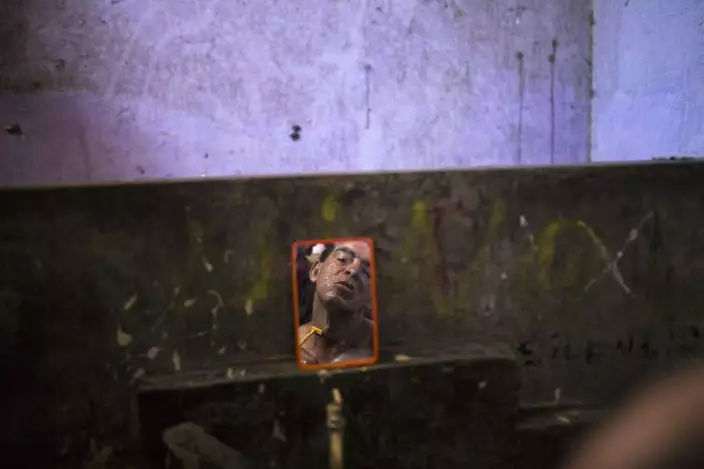
In this March 19, 2020 photo, Cesar Alegre is reflected in a mirror as he prepares for his day in the communal bathroom of a deteriorating building nicknamed “Luriganchito” after the country’s most populous prison, in Lima, Peru. Sometimes Alegre begs in markets; sometimes he sells candies. It is a task that was hard at the best of times, but with a month-long quarantine that has forced millions of Peruvians to stay home to help curb the spread of the new coronavirus, it has become much harder. (AP PhotoRodrigo Abd)
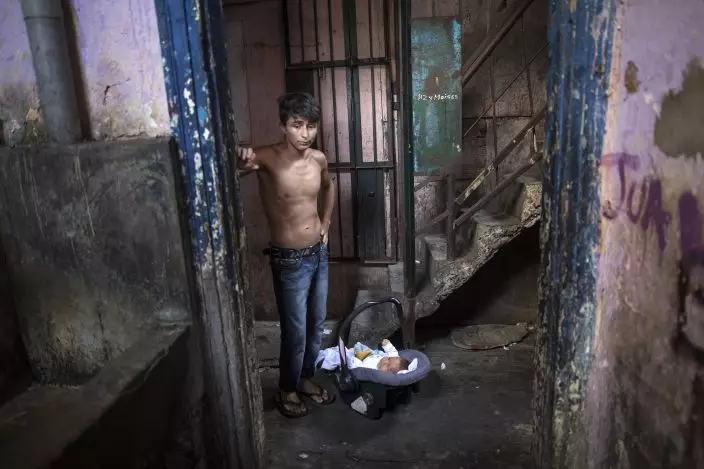
In this April 3, 2020 photo, ex-convict Julio Ramos stands next to his 3-month-old son Jose, inside the deteriorating building where he lives nicknamed “Luriganchito” after the country’s most populous prison, in Lima, Peru. “I do not want my children to suffer as I did, I want to give them the love I never had”, said the 26-year-old father of 3 boys. (AP PhotoRodrigo Abd)
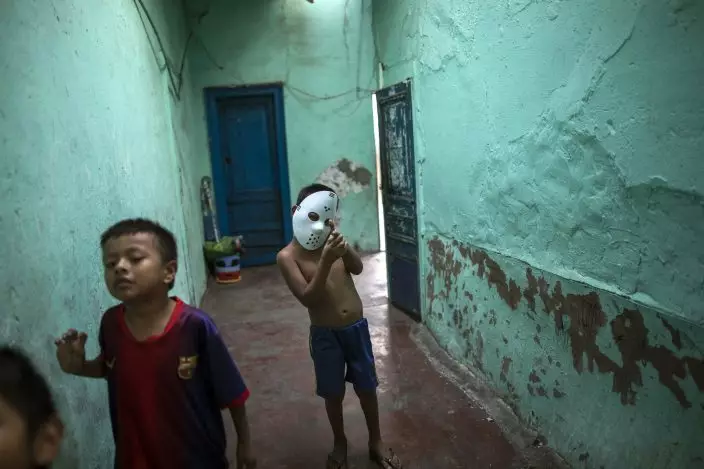
In this March 24, 2020 photo, children, one wearing a Jason Halloween mask, play inside the deteriorated house where they live nicknamed “Luriganchito,” after the country’s most populous prison, in Lima, Peru. The reference is not only because the residents are mostly ex-convicts, but also because the interior of the house is like a Latin American prison, with narrow passageways, without light and little air. (AP PhotoRodrigo Abd)
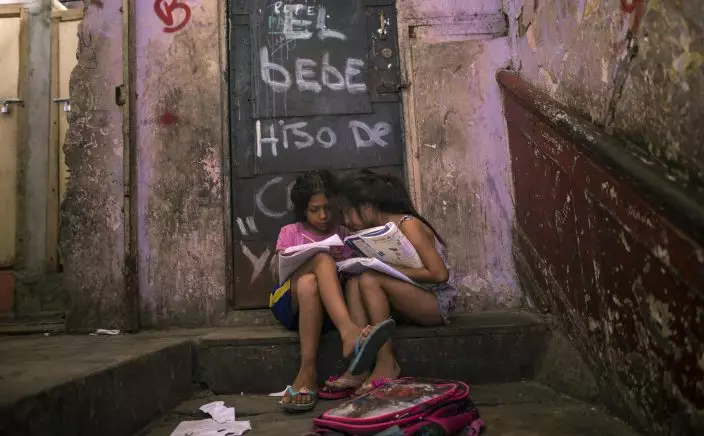
In this April 5, 2020 photo, Grace Lopez and Iunzu Asca do their homework sitting on a stoop inside the deteriorating building where they live, nicknamed “Luriganchito” after the country’s most populous prison, in Lima, Peru. The building is a relic from the area's historic era. But inside its now-cracked walls is a warren of narrow, dark passageways that smell of damp clothing and marijuana. (AP PhotoRodrigo Abd)

In this March 29, 2020 photo, Ivonne Garcia changes her daughter's diaper in her small room while her homeless cousin naps nearby, in the deteriorating building nicknamed "Luriganchito" after the country's most populous prison, in Lima, Peru. Because of the strict measures that include restricted public circulation taken by the government amid the new coronavirus pandemic, Garcia is allowing her homeless cousin to sleep in a corner of her room. (AP PhotoRodrigo Abd)
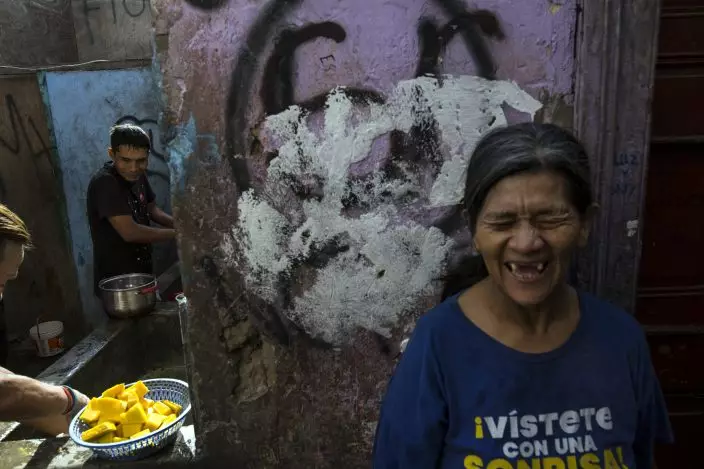
In this March 19, 2020 photo, Nelida Rojas, wearing a T-shirt emblazoned with a message that reads in Spanish: "Dress yourself with a smile", laughs as she jokes with fellow residents as she waits her turn to use the communal laundry area, inside a rundown building nicknamed "Luriganchito" after the country's most populous prison, in Lima, Peru. Rojas, 59, had a stroke two years ago that partially paralyzed her body. She now uses crutches to get around and spends her days begging for alms. (AP PhotoRodrigo Abd)
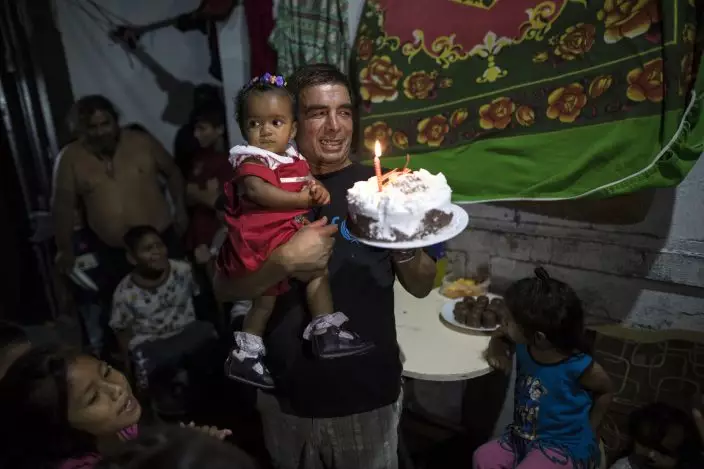
In this March 18, 2020 photo, Cesar Alegre carries his daughter Valerie while holding her store bought cake, as he and fellow residents prepare to mark her first birthday in the deteriorating building where they live, nicknamed “Luriganchito” after the country’s most populous prison, in Lima, Peru. Since the nationwide lockdown decreed by the government to curb the spread of the new coronavirus, Alegre and his children walk to a market every other day in hopes that merchants give them the overripe or expired food that nobody wants to buy. (AP PhotoRodrigo Abd)
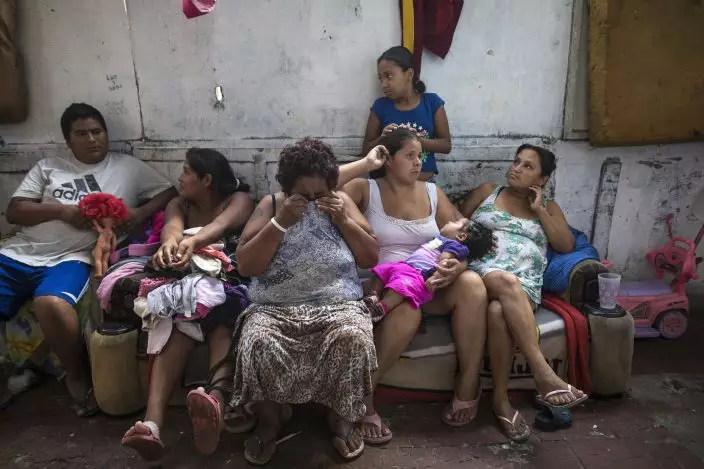
In this March 23, 2020 photo, Carmen Rosa de la Cruz covers her mouth with her shirt as she sneezes while sitting with fellow residents as they gather for a prayer meeting in a communal area of a deteriorating building nicknamed "Luriganchito" after the country's most populous prison, in Lima, Peru. 45 families rent the small rooms in "Luriganchito", just a few blocks from the presidential palace, for 100 soles or 87 U.S. dollars per month. (AP PhotoRodrigo Abd)
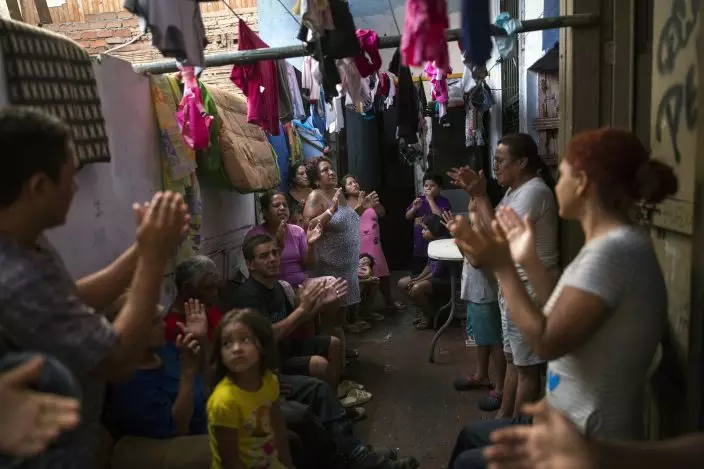
In this March 20, 2020 photo, residents join in a prayer meeting in one of the few communal spaces of the deteriorating building nicknamed “Luriganchito” after the country’s most populous prison, in Lima, Peru. The global COVID-19 pandemic has spotlighted the wide gap between the rich and poor in Latin America and economists say a looming economic recession worse than any since World War II could push the continent's long-suffering poor into even more dire circumstances. (AP PhotoRodrigo Abd)
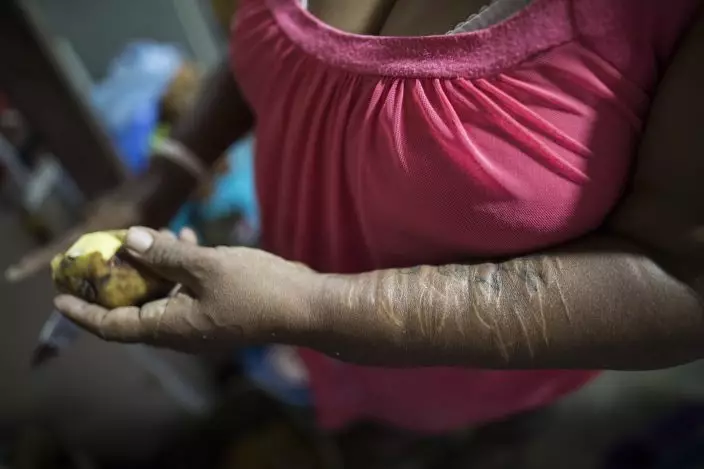
In this April 5, 2020 photo, Carmen Rosa de la Cruz, whose arm is scarred from self-harm, peels potatoes as she prepares a soup inside the deteriorating building nicknamed “Luriganchito” after the country’s most populous prison, in Lima, Peru, during a nationwide lockdown to help contain the spread of the new coronavirus. (AP PhotoRodrigo Abd)
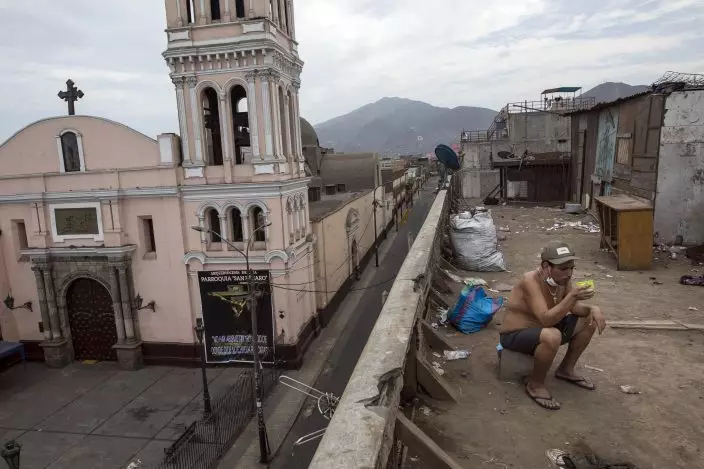
In this April 5, 2020 photo, Raul Coyantes eats his breakfast on the rooftop of the deteriorating building nicknamed "Luriganchito" after the country's most populous prison, where he rents a room, in Lima, Peru. Located just a few blocks from the presidential palace, the old house sits opposite San Lazaro church, founded in 1650 as a hospital for refugees from a leprosy plague. (AP PhotoRodrigo Abd)
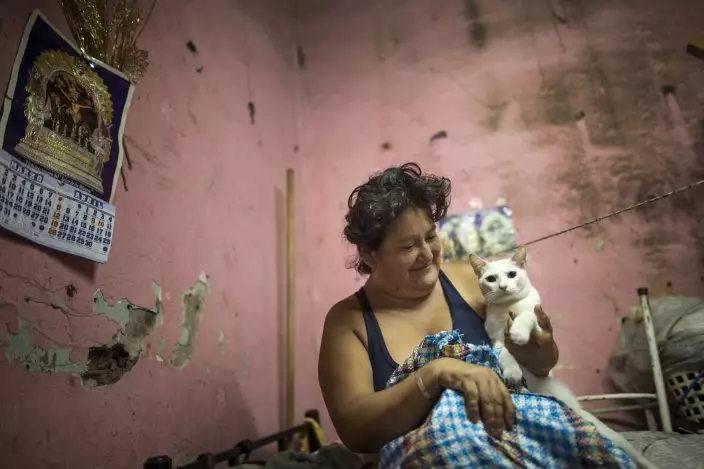
In this April 3, 2020 photo, Zulema Aguinaga smiles at her pet cat as she starts the day inside her small room she shares with her son and elderly aunt, in a deteriorated house nicknamed “Luriganchito,” or “Little Lurigancho,” after San Pedro de Lurigancho, the country’s most populous prison, in Lima, Peru. The government began enforcing strict new measures to curb the spread of the new coronavirus, restricting public movement by gender. Women are allowed to go out on Tuesdays, Thursdays and Saturdays. (AP PhotoRodrigo Abd)
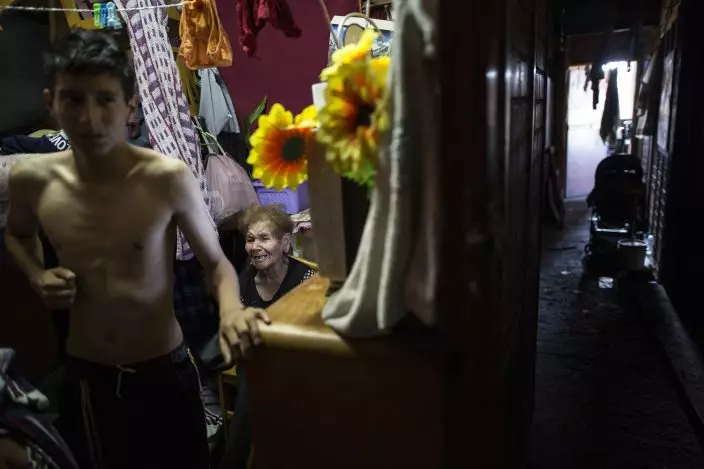
- In this March 19, 2020 photo, Maria Isabel Aguinaga sits inside her room in the rundown building nicknamed “Luriganchito” after the country’s most populous prison, in Lima, Peru. The reference to the prison is not only because the neighbors are mostly ex-convicts, but also because the interior of the house is like a Latin American prison, with narrow passageways, without light and little air. (AP PhotoRodrigo Abd)
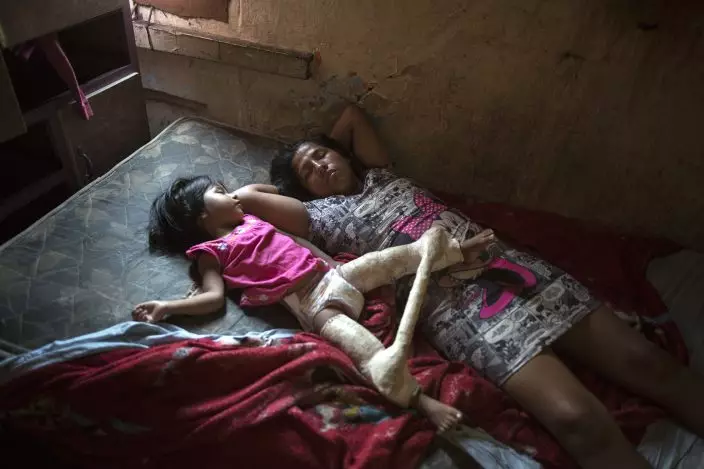
In this March 19, 2020 photo, Nilu Asca and her 2-year-old daughter Darleth, who wears a spica cast to treat hip dysplasia, sleep inside their small room inside a building nicknamed “Luriganchito,” after the country’s most populous prison, in Lima, Peru. The 24-year-old single mother spends her days begging to provide for her two children and raise the 10 soles, about three U.S. dollars, for her daily lodging expense. (AP PhotoRodrigo Abd)
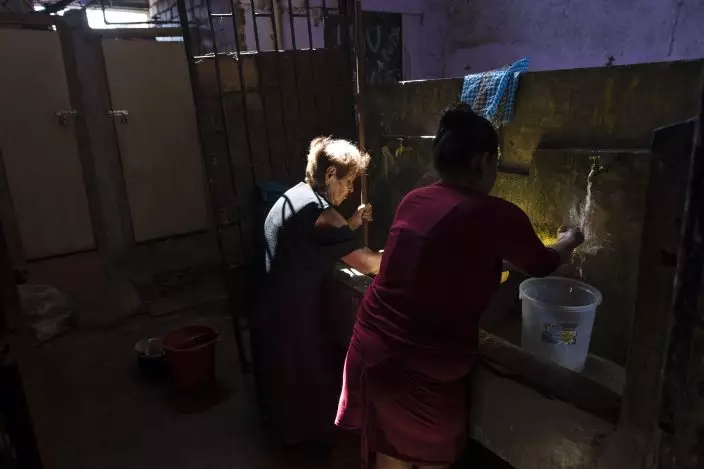
In this March 23, 2020 photo, Maria Isabel Aguinaga washes her clothes in a communal laundry area of a deteriorating building nicknamed “Luriganchito” after the country’s most populous prison, in Lima, Peru. Aguinaga who could no longer afford to pay her rent now lives with her niece Zulema in the sprawling shared home that houses 44 families. (AP PhotoRodrigo Abd)
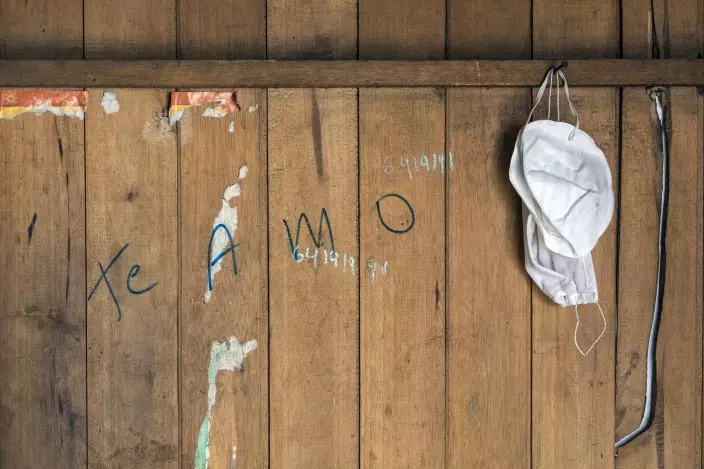
In this April 5, 2020 photo, protective face coverings belonging to Raul Coyantes hang from a nail inside the small room he rents in a deteriorating building nicknamed “Luriganchito” after the country’s most populous prison, in Lima, Peru To try to address the coming humanitarian disaster, Peru has begun distributing about $400 million to feed 12 million poor people for one month. But the money doesn't seem to be reaching most of the families at Luriganchito . (AP PhotoRodrigo Abd)


